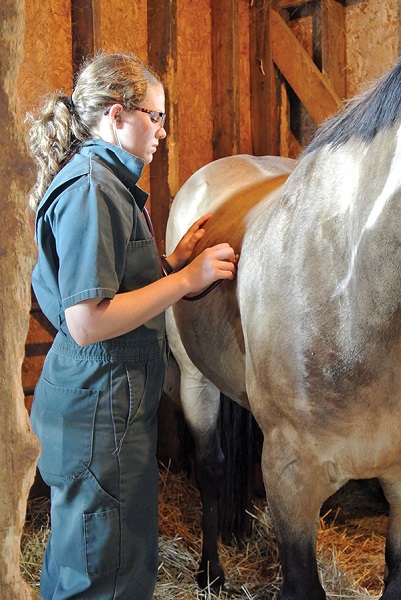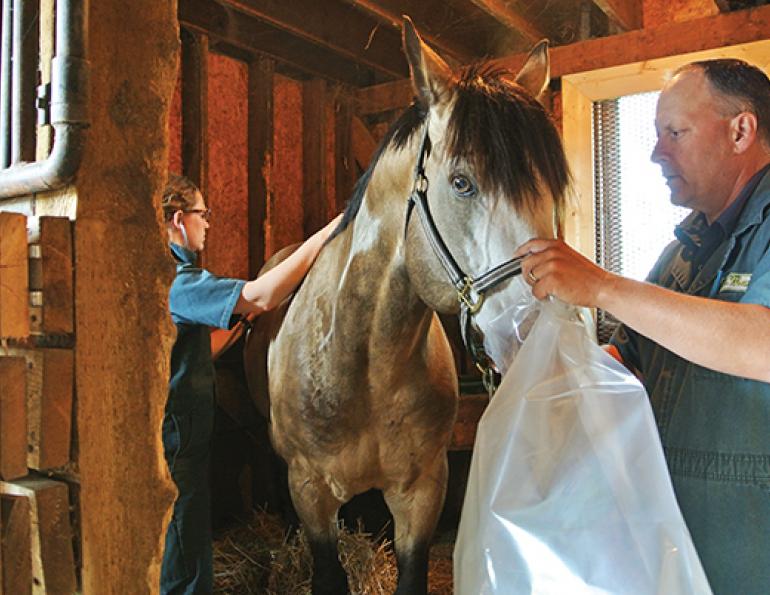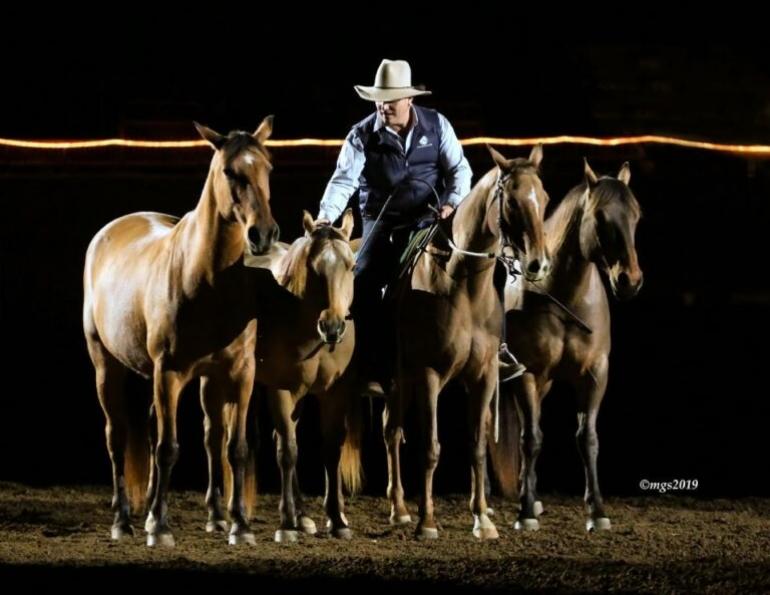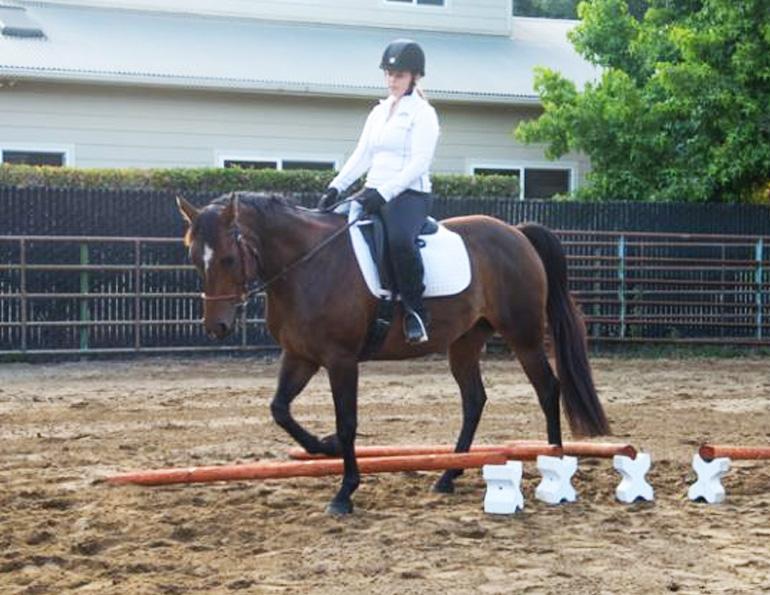By Hayley Kosolofski
Sucking air through a straw. Those are the words that many people with asthma use to describe their frightening struggle to breathe during an asthma attack.
Now imagine a thousand-pound animal experiencing the same panic-stricken feeling.
For a horse, that’s what it’s like during an acute episode of recurrent airway obstruction, or heaves. As the horse’s airways narrow, it increases its breathing effort until it starts to cough.
This debilitating disease detracts from horses’ quality of life and limits their careers. And while RAO affects many horses in Western Canada, veterinarians still don’t fully understand the problem.
“Like many veterinarians, I have struggled with understanding the disease process of RAO and treatment of severe cases,” says Dr. Michelle Husulak, a resident in equine field service at the Western College of Veterinary Medicine (WCVM). She and her supervisor, Dr. Julia Montgomery, are conducting a study investigating treatment options for horses with RAO that will hopefully answer some questions about the disease process.

Equine resident listening to lung sounds (horse). Equine field service resident Dr. Michelle Husulak examines one of the horses enrolled in her RAO study at the Western College of Veterinary Medicine. Photo: Hayley Kosolofski
In human medicine, current research in asthma suggests bacteria may play a role in the disease in people. As well, horses with RAO often have bacteria in their lungs — but researchers still don’t understand the importance of the bacteria in relation to the disease.
“Often we find bacteria that are not causing a pneumonia and may or may not be normal flora. In these cases we are unsure if treatment with antibiotics is required,” explains Husulak.
She wants to determine if targeting these bacteria with antibiotics — on top of traditional therapy for heaves — helps the horses improve. Answering that question may also shed light on the role of bacteria in the disease process.
Traditional therapy for RAO consists of environment management — reducing exposure to dust and mould by keeping the horse outdoors on pasture, soaking hay or feeding hay cubes, and using a low-dust bedding such as wood chips. As well, veterinarians often prescribe drug therapy: corticosteroids such as Dexacort® (dexamethasone) to reduce lung inflammation along with bronchodilators such as Ventipulmin® (clenbuterol) to open up the horse’s airways.
Husulak wants to know if adding in antibiotic therapy will further help the horses improve from an acute episode of heaves.
“Do these horses need to be treated with antibiotics to help resolve their clinical symptoms, or is treating with antibiotics considered inappropriate use of antibiotics?” says Husulak. “This is a question I would like to answer.”
For her research, Husulak is recruiting horses with heaves in the Saskatoon area. Before the horses can be enrolled in the study, the diagnosis of RAO has to be confirmed and bacteria must be present in their trachea.
Once they’re part of the study, Husulak and members of her research team give horses a thorough physical examination with special attention paid to the lungs. The clinicians use a technique called “rebreathing” where they place a plastic bag over the horse’s muzzle for a few minutes so the animal rebreathes the air it expires. The horse will naturally breathe deeper and allow Husulak to hear more lung sounds with her stethoscope.
The research team also performs two tests — the tracheal wash and bronchoalveolar lavage — to retrieve samples from each horse’s upper and lower airways.
Once the veterinarians can confirm an RAO diagnosis and bacteria are found in the trachea, they start the horses on a treatment protocol. They also ask owners to keep their horses outdoors as much as possible and to soak their hay. As well, all of the RAO-positive horses receive steroids and bronchodilators.
To determine if the antibiotic therapy is effective, half the horses receive antibiotics (the treatment group) while the other half receive saline (the control group). Neither Husulak nor the horse’s owner knows whether the horse has received antibiotics or saline — ensuring that there isn’t any bias when assessing the horse’s improvement.
After the treatment course is finished, Husulak visits each horse a second time to re-perform the physical exam, tracheal wash, and bronchoalveolar lavage, and to assess its improvement.
How does she determine if the horses have improved?
“We are looking at the clinical signs such as respiratory rate and effort, nasal flaring, nasal discharge and lung sounds. We are also looking at the tracheal wash bacterial culture, and the inflammatory cells and proteins on bronchoalveolar lavage,” says Husulak, who has tested two horses so far.
She and her colleagues will continue testing horses for the study over the next few months. And ultimately, if results of the WCVM project show that antibiotic therapy can help horses with RAO to recover from acute episodes of the disease, veterinarians would have something that could help their equine patients — as well as their clients — breathe easier.
Hayley Kosolofski of Sherwood Park, AB, is a third-year veterinary student who was part of the WCVM’s Undergraduate Summer Research and Leadership program in 2014. Hayley’s story is part of a series of articles written by WCVM summer research students.
Main Photo: Drs. Michelle Husulak and Steve Manning use a plastic bag to encourage horses to breathe deeper. This “rebreathing” technique allows veterinarians to hear more of the horse’s lung sounds. Photo: Hayley Kosolofski
This article was originally published in the October 2015 issue of Canadian Horse Journal.
Also see:




















